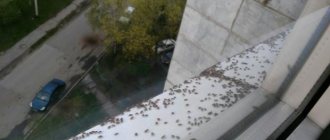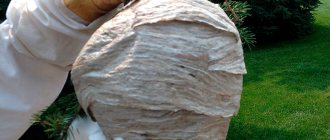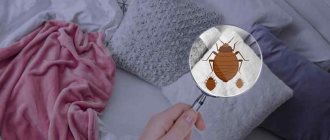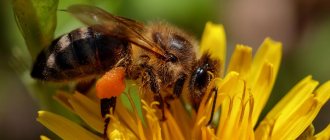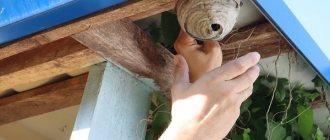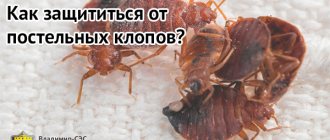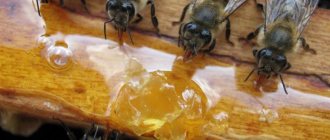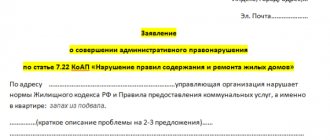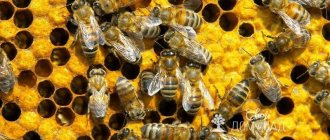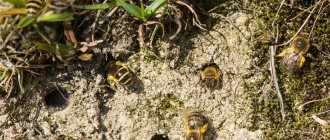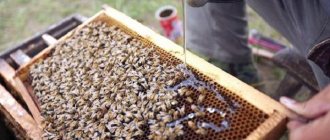Bees are an integral part of the ecosystem. There is a theory that with the death of the last insect, death will come for all life on the planet. Like people, bees value comfort and silence, which may be why they are drawn to human habitation. Crawling into the foundations of houses and occupying garden trees, they no longer seem to be such planetary guardians of life. The only thought when meeting striped neighbors is to run. However, long-term practice of coexistence works wonders; it is possible to get rid of bees without resorting to radical methods.
Where can bees settle?
Bees live in swarms. As soon as a second queen appears in a formed family, she heads a certain number of worker insects and drones and moves to a new place of residence: in a hollow tree, in a crevice, in the ground, but also in a window frame or under a roof.
Bees that try to “take over” a summer cottage can be either wild or domestic. In the latter case, neighboring beekeepers should be notified: the swarm has probably escaped from the apiary.
Under the roof
The roof of the building has a complex structure. A bee's nest can be placed in any cavity of suitable size and is sometimes hidden in such a way that it takes a lot of effort to detect and neutralize it.
Typical places are:
- in the attic, that is, inside the building. Insects can fly in through the dormer window, an opening formed by a peeling roof;
- outside, right under the overhanging roof. Bees build a nest in the rafters, or more precisely, in the gap between the rafter leg and the roofing material. It is easier to get rid of bees because the nest is in plain sight;
- the most difficult option is that the hive is located between the sheathing and the casing, in the resulting cavity. Finding it is not easy, and disarming it is even more difficult;
- bees live in brick chimneys. To drive them out, you just need to heat the stove.
Important! A bee's nest is often confused with a wasp's nest or with the habitat of hoverflies. Before you do anything, you need to establish what kind of insects live under the roof.
In the wall of the house
The walls of the building provide a convenient basis for forming a nest. Most often, bees settle in wooden buildings, however, brick houses are also suitable for them. Typical places are:
- on any section of a wooden wall - insects gnaw holes in the wood and create entire labyrinths under the surface;
- in wooden window frames – the window design presents a convenient structure due to right angles and cracks. And in the frame the bees easily make moves;
- On brick walls, insects build their habitat using architectural elements: arches, half-columns, door frames, balconies.
Getting rid of bees in the walls and roof of a wooden house requires non-trivial solutions. Experts recommend luring out the insects first, since it is very difficult to destroy their nest hidden deep in the timber.
In the garden
Wild bees are more likely to settle in the garden, as this option is closer to their natural habitat. The most likely places are:
- a hollow tree is the most obvious solution;
- trunk crevices, depressions formed by the interweaving of branches and deformation of the trunk. In this case, part of the hive is in the tree, and part is built on;
- hole in the ground - such a nest is built by earth bees.
Important! Insects create their habitat near a permanent source of water. That's why they move to garden plots.
Why are bees dangerous?
A bee sting is always painful and toxic, and its consequences can cause a severe local reaction. As a rule, the affected area turns red, swelling, itching appears, and the temperature rises. During the first 24 hours, symptoms subside. Bites in the area are considered especially dangerous:
- eye (possible complications - conjunctivitis, panophthalmia, blepharitis);
- mucous membranes of the mouth and throat (swelling can cause difficulty breathing);
- lips and neck (thin skin is more sensitive to swelling).
Bee venom is a unique combination of proteins, fats, carbohydrates, acids, various chemical elements and biologically active substances. It is the latter that cause toxic and allergic reactions.
A bee sting is always painful and toxic
Table: dangerous substances included in bee venom
| Name | Impact on the body |
| Melitin (poison) |
|
| Histamine (amino acid) |
|
| Apamin (natural peptide, neurotoxin) |
|
| MSD-peptide (2% of the total volume of poison) |
|
| Phospholipase A2 | Destroys the cell membrane |
The value of bee venom lies in its balance. Along with active toxins, it contains substances with a high therapeutic index. For example, the peptide adolapine is a natural pain reliever, and cardiopep has regulatory properties.
For children, pregnant women and people who have not encountered bees before, the consequences can be much more serious. An allergic reaction is the most dangerous complication after such a meeting. Symptoms:
- increased body temperature;
- gastrointestinal disorders;
- skin rashes (in particular urticaria);
- Quincke's edema (manifests in the form of partial or complete acute swelling of the face or limb);
- headache;
- dyspnea.
In rare cases, disruption of the cardiovascular system and anaphylactic shock occurs. Failure to treat usually results in death.
Rapidly growing swelling may be a symptom of an allergic reaction
Harm and benefit
Before poisoning bees, scaring them away or moving them to another place, it is worth assessing the benefits and damage that insects can cause. Both wild and domestic honey bees are the main pollinators of garden and vegetable crops. Their presence is a guarantee of a good harvest.
However, too many insects or poor placement of the nest, such as inside a wooden wall, pose a danger. Domestic bees rarely attack first; wild bees are much more aggressive and their poison is stronger. If a swarm lives right in a window frame or in a wall, such a neighborhood poses a threat.
How to Contain Your Bees
Every effort should be made to ensure that the family has everything they need on the territory: drink, free space, feeding.
- Breed non-aggressive breeds, for example, carnival or karpatka.
- Give your neighbors a tour and show them that insects do not pose any threat.
- Enclose the area with a high fence or chain-link mesh with small cells.
- Turn the hives in the opposite direction from their neighbors.
- Build a convenient drinking bowl.
If all conditions for the favorable keeping of bees are met, there is no need to worry that they will be aggressive towards people.
And finally, some important tips for those who want to carry out their own manipulations to combat wild wasps, bees and hornets:
- You should not knock down a nest with a stick in which wasps live - they can become overly aggressive.
- When getting rid of a nest, you should protect your face and body with clothing that reliably protects you from bites.
- When spraying with poison, animals and children must be removed from the area.
- If during manipulations one insect flies out of the nest, you should not try to poison it, since it will immediately announce this to its relatives.
Fighting methods
Getting rid of bees involves 2 main solutions: repelling and destroying. If insects fly from a neighboring area where their hive is located, the simplest means are sufficient. For example, an unpleasant odor causes most bees to fly away from an area. However, the substance must be selected taking into account the “taste” of honey collectors. Such an effective insecticide against pests as birch tar hardly scares bees.
Effective remedies for wasps and bees
If a nest is found on the site - a mink in a garden bed, a hive in a wooden wall - more drastic methods are used. It is best to lure the bees out of the nest and transport the swarm to the forest. As a last resort, they are destroyed.
Folk remedies
There are many ways to repel or poison insects. Their habits are well known, so it is not difficult to find the most accessible and safe way. You shouldn’t try to destroy them right away: there are many ways to force bees to leave their hive.
Peppermint and clove essential oil
Insects are very sensitive to odors. The simplest folk remedy for getting rid of bees in the country is the essential oil of cloves, mint, and mustard. They can't stand these scents.
Aroma lamps generously seasoned with essential oil are placed along the fence from which insects fly. An alternative option is to place pieces of fabric soaked in an aromatic substance on the fence.
Candles with citronella provide the same effect. Burning candles are placed along the veranda or on the table where the evening is spent. The aroma repels not only bees, but also mosquitoes.
To protect yourself from their attention, just drop a drop of mint or clove essential oil on the bend of your elbow and in the hollow between your collarbones. You can use a repellent containing similar essential oils.
Bags of mothballs
The smell of mothballs also irritates insects. Linen bags are filled with mothballs and hung on the fence, on fruit trees, on the walls. The aroma is so unpleasant to bees that it can force them to leave the hive if they have settled, for example, in the hollow of an apple tree.
Vinegar solution
If honey collectors are interested in the source of water at their summer cottage, then you can get rid of them by setting up water traps. To do this, cut off the top 1/3 of the plastic bottle and insert it with the neck down. The container is filled with a vinegar solution: 15 ml of ordinary essence per 2 liters of water. Traps are hung along the fence on nails.
If you replace vinegar with a 2% salt solution, the bees in such a trap will die. This remedy is resorted to if a neighboring beekeeper refuses to take action: move the hives away from the fence so that the bees fly less into the area.
Basil
The smell of basil repels insects: bees, wasps, mosquitoes. However, only fresh living leaves have this property. To protect yourself from invasion, basil is planted along the fence or around the veranda. The plant is well accepted, but needs abundant watering, and most importantly, solar warmth. Basil will not grow in the shade.
Onion garlic
The pungent smell of plants irritates the human sense of smell. It is intolerable to bees. A bed of garlic or onions, planted along a fence or just in the garden, will repel almost all insects.
Interesting! Feeding bees with onions and garlic in sugar syrup increases immunity and prolongs their life.
Mint
Live mint or lemon balm repels insects no worse than essential oil. The plant easily takes root in almost any soil and does not require care, although it prefers sunny areas. The bed is laid out along the fence or next to the house.
Citronella, a lemongrass plant, has the same effect. They grow it more often in pots than in garden beds, and in the summer they take it outside and install it along the veranda.
Lavender
Beautiful unpretentious flowers drive away wasps, bees, and mosquitoes. The plant is not afraid of common pests, so lavender can be planted right under a window or near the veranda. Dried flowers - whole or in sachet form, for example, are not as effective.
Sagebrush
It not only irritates wasps and bees, but can also poison, since the plant sap contains toxic substances. Not everyone likes the specific smell of wormwood, so they try not to plant it near the house. But a few bushes along the fence or near the garden will force honey collectors to fly around the dacha plot.
Wormwood poses a danger not only to mosquitoes or wasps, but also to plants. Garden crops or flowers cannot be planted next to it.
Citrus juice
The smell of lemon and orange is unbearable for honey collectors. Citrus juice is used to wipe wooden parts: window frames, doors or even walls. If a swarm has settled inside the beam, lemon juice is dripped directly into the bee passages.
Dried orange or lemon peels will help repel insects. They are laid out in living quarters, on the veranda or in places where bees and wasps are spotted.
Special bee repellers
If folk remedies fail, they resort to various types of scaring devices. Some of them are used indoors, some are used outdoors. Repellers operate on electric current or batteries.
Anti-mosquito lamps
A device that not only repels but kills insects. The lamp emits ultraviolet radiation, which attracts bees, wasps, and mosquitoes. They land on the grid and die from electric shock. Devices are selected based on power and range. Lamps are used only inside the building, usually they are placed near the food storage area.
Ultrasonic repellers
The device emits ultrasonic waves that repel bees. Insects are very sensitive to sounds: they are afraid of even ordinary loud noise. But the latter is also unpleasant for humans. Humans cannot hear ultrasound, but it has an effect on mosquitoes, wasps, hornets, and rodents.
The device is universal and can be used indoors. The repeller runs on salt or solar batteries. A significant disadvantage of the device is that it only lasts 2–4 weeks.
Anti-mosquito lamp
The device works similarly to mosquito lamps, but generates both ultraviolet and visible radiation. The range is 50 m. The lamp runs on electricity, so it is used only in the building.
Disadvantage: the device only has a deterrent effect when it is turned on. During the day you will have to use another product.
Chemicals
It is easier to poison bees this way than to scare them away. They use chemicals when they want to drive out insects. It is impossible to use them constantly, like essential oils or plants: the substances are toxic to humans:
- gasoline or diesel fuel is poured into the socket. In this case, some of the insects die, and the rest leave the hive forever. You need to act very carefully, as gasoline vapors can easily cause poisoning;
- carburetor cleaner in aerosols. It works differently depending on the type. The cleaner is sprayed onto the nest found under the roof or in a tree;
- Pesticide powders are extremely dangerous for bees. However, such a remedy is used as a last resort and only when the area is terrorized by wild insects. If a domesticated swarm dies as a result of treating a garden with pesticides, its owner has the right to sue;
- special sprays are produced in the form of aerosols. Their action is different. Thus, the “Clean House” spray based on cypermethrin kills insects, causing paralysis. You can use it inside the house. "Dichlorvos" is used only to destroy the nest, since the drug is highly toxic.
Traps
If bees have settled in the wall, it is useless to scare them away - you need to lure them out of the house. For this purpose, traps are built. In design they resemble a birdhouse, but with a very small entrance.
Effective DIY wasp traps
A narrow hole is made in the bottom of the bait. Cut off the neck of the bottle and cut the top part in the form of petals. Then the container is secured in the hole at the bottom so that the petals fit inside and fix the bottle. Water with washing liquid or saline solution is poured into it. The trap is fixed on a tree next to the hive.
To lure bees, jam, sugar cubes, and honey are placed in it. Insects flock to the smell, penetrate inside and end up in a bottle with a poisonous solution.
Smoke bombs
A universal remedy against many types of insects. It is used both inside the house and in open areas. The main advantage is the wide range of action.
The smoke bomb is selected taking into account the desired effect:
- hexachlorane is a systemic insecticide. Affects the nervous system of insects and causes paralysis. It is dangerous for both humans and domestic animals, therefore it is used only in open spaces;
- Didecyldimethylammonium bromide is a disinfectant with antibacterial and fungicidal effects. Drives away and destroys garden pests;
- permethrin is a contact insecticide. Included in many aerosols, it paralyzes bees, wasps, and hornets;
- checkers with sulfur - slow oxidation leads to the release of sulfur dioxide. The substance kills insects. Usually used indoors.
The advantage of a smoke bomb is the ability to treat the most inaccessible areas. Smoke penetrates into any cavities and cracks. Using checkers, you can drive insects out of wooden walls, from the attic, from under the roof.
Types of bees
Bees belong to the most evolutionarily developed order of Hymenoptera. Distinctive features in behavior are considered to be busyness and the absence of unnecessary aggression. However, wild species are usually more hostile than domesticated ones; even an unpleasant smell or sound can provoke their attack. There are social (living in a large swarm), semi-social (forming small colonies) and solitary insects.
Solitary bees should not be destroyed; as a rule, they are not aggressive and are valuable pollinators. Solitary bees include osmia, carpenters, leaf cutters, etc. Sometimes such bees acquire a small colony.
Wild earth and tree bees
Ground bees include many Red Book species. Representatives reach a size of 2 cm. They are characterized by a black abdomen, a dark brown head abundantly covered with black fluff. Yellow spots are visible in the jaw area. The differences between the sexes are minor. Like most Hymenoptera, they live in families. At the same time, young animals rarely fly far from the main nest; settling nearby, they can build an extensive underground dwelling. Bees prefer to swarm under the soil layer; depending on the region, they choose both sandy and fertile types of soil.
The section of tree bees includes many unstudied species. Insects play an important role in pollination; some representatives belong to honey-bearing species, while others destroy pests on the site. From the point of view of experts, the destruction of such bees is not inappropriate, since their sites near a human home are a temporary phenomenon. The size of tree bees ranges from 2 mm (dwarf bees) to 4 cm (a species found in Indonesia). The color is often monochromatic and dark. Dry (and even rotten) wood is usually chosen as a place for swarming.
Photo gallery: varieties of commonly encountered wild bees
Andrena Clarkella resembles a bumblebee in appearance, with a distinctive feature being her red hind legs.
The carpenter bee (also known as the “tree bee”) is a peaceful species, characterized by large dark purple eyes and wings of the same shade.
The leaf cutter uses the greenery of bushes and trees as building materials for the nest; Insects can be detected in the area by the characteristic round holes on the leaves
Galikt sphecodex has a bright fiery or green color, representatives of the species are usually small in size
Rather than building his own hive, Woolbit prefers to occupy someone else's home, and lines the inside of the nest with animal hair.
Nomad looks like a wasp
The Burzyan (Bashkir) bee belongs to the honey-bearing species, is found in the forests of Bashkiria, and is often domesticated due to its exceptional working abilities
Prevention of occurrence
It is unwise to completely get rid of bees: they are the main pollinators of plants. To prevent them from entering the house or to prevent a re-invasion, perform the following actions:
- wooden walls, window frames and doors are painted, as the smell of paint repels bees;
- spray verandas and windows, as well as living quarters with sprays or wipe the surface with mint decoctions and tinctures;
- in places where insects are spotted, lay out the peels of lemon, orange, and tangerine;
- cracks in window frames and doors are sealed with sealant;
- Plants that repel insects are planted around the house or along the fence.
It is not advisable to destroy honey collectors. Even if a swarm of wild bees has settled under the roof, first of all, you need to contact an experienced beekeeper. He will be able to lure out the swarm and move it to a more suitable place.
If you can't get the nest
Bee milk
Many people complain that the bees have made a nest under the roof and cannot be reached. What to do?
In those places that are difficult to reach, remote access is used. The process of removing the nest in this case is very dangerous, so you can start it only with careful preparation. First of all, you need special ammunition:
- A beekeeper's hat, which is distinguished by its wide brim with a net attached to it.
- Protective glasses.
- A suit consisting of a jacket and pants made of thick fabric.
- Rubber Shoes.
All other devices should be on hand at all times so as not to delay the process and cause less insect aggression. In addition, you need to clear an escape route if something goes wrong and you have to quickly leave the nest. Most likely, such movements will need to be carried out backwards, and very quickly.
In addition, you need to make sure that all other household members leave the territory for a while. All manipulations must be carried out at a late time, while the insects are all in the nest. In addition, sleepy bees will not immediately understand what is happening to their home.
conclusions
- An excessive number of bees in a summer cottage, and even more so a swarm that has settled right in the wall, poses a danger. Insect bites cause allergies and are extremely unpleasant.
- To scare away bees, plants with an odor intolerable to them are planted, aroma lamps are installed along the fence, and dried flowers are hung on the balcony.
- If you need to drive insects out of the hive, they resort to more effective means: fill the nest with gasoline, spray it with sprays.
- Special devices help get rid of insects: aroma lamps, ultrasonic repellers.
- If it is necessary to expel a swarm, contact a beekeeper. The specialist lures out the insects and transports them to a safe place for them.
How to scare away neighbor bees from your property
Neighbor bees often cause trouble, especially if the hives are located on a neighboring property. How can you scare bees away from your area in this case?
There are several ways to try to resolve the matter peacefully:
- fenced with a fence 2 meters high;
- ask to move the hives away from the site;
- plant fast-growing trees and shrubs;
- raise the hives to a height so that their flight path is higher than human height.
If neighboring bees are attracted to honey-bearing flowers and trees on your site, then you can try planting cloves, calendula, and peppermint near them. These plants repel insects with their scent.
If you cannot resolve the matter peacefully with your neighbor, then you can resort to the letter of the law. To do this, it is worth checking whether the hives are located at a distance of 3-6 meters from neighboring areas. It is also worth contacting the gardening association so that they can check the apiary logbook and veterinary service records with the beekeeper. If there was a bite, it should be recorded by a doctor and then, with this certificate, try to resolve the conflict with the neighbor. Otherwise, you should contact the local police officer.
Video
The process of fighting bees has its own subtleties and characteristics. In order to competently and effectively exterminate insects, watch the following videos:
Young mother, wife and part-time freelancer. Being a lawyer by training, I am accustomed to collecting and providing the most complete and reliable information. Constantly improves in the professional field and strives for personal growth and development.
Found a mistake? Select the text with the mouse and click:
There are special traps to combat moths. The sticky layer with which they are covered contains female pheromones that attract males. By sticking to the trap, they are eliminated from the reproduction process, which leads to a decrease in the moth population.
Stretch ceilings made of PVC film can withstand from 70 to 120 liters of water per 1 m2 of their area (depending on the size of the ceiling, the degree of its tension and the quality of the film). So you don’t have to worry about leaks from neighbors above.
The habit of using an automatic washing machine “sparingly” can lead to the appearance of an unpleasant odor in it. Washing at temperatures below 60℃ and short rinses allow fungi and bacteria from dirty clothes to remain on internal surfaces and actively multiply.
Fresh lemon is not only suitable for tea: clean dirt from the surface of an acrylic bath by rubbing with half a cut citrus, or quickly wash the microwave by placing a container of water and lemon slices in it for 8-10 minutes at maximum power. The softened dirt can simply be wiped off with a sponge.
Threads made of gold and silver, which were used to embroider clothes in the old days, are called gimp. To obtain them, the metal wire was pulled for a long time with pliers to the required fineness. This is where the expression “to drag out the rigmarole” came from - “to do long, monotonous work” or “to delay the completion of a task.”
If your favorite things show the first signs of gestation in the form of untidy pellets, you can get rid of them using a special machine - a shaver. It quickly and effectively shaves off clumps of fabric fibers and returns things to their proper appearance.
The dishwasher cleans more than just plates and cups. You can load it with plastic toys, glass lamp shades and even dirty vegetables, such as potatoes, but only without using detergents.
Before removing various stains from clothing, you need to find out how safe the selected solvent is for the fabric itself. It is applied in a small amount to an inconspicuous area of the item from the inside out for 5-10 minutes. If the material retains its structure and color, you can move on to stains.
The easiest way to remove scale and carbon deposits from the soleplate of the iron is with table salt. Pour a thick layer of salt onto the paper, heat the iron to maximum and run the iron over the salt bed several times, applying light pressure.
Getting rid of wasps in a private home
To get rid of wasps in the house, you need to find out where their nests are. To do this, you will need to inspect the home. The most favorite places to build hives are corners, windows, attics and facades. They can even appear on the wall. Insects can gnaw passages inside through insulating material, wooden blocks, and cement mortar. In this case, it is difficult to track them down, and this must be done, otherwise it will be impossible to find the hive.
Wasps are carriers of many dangerous diseases, including E. coli
At this time, insects are sleeping, so the risk of being stung is sharply reduced. You will also first need to wear special clothing and a mask to protect your eyes, hands and face. You can wear rubber gloves, but it is best to get a special uniform. To protect your eyes, a gas mask is the optimal solution. If there is no special uniform, then it is recommended to wear thick clothing through which the insect cannot sting.
If the nest is within visibility and accessibility, then you can fight wasps using one of three means. Take a bucket or pan, fill it with water and bring it to the wasp’s house from below. The hive must be completely immersed in liquid. You need to hold the nest for about 7 minutes: during this time it will dissolve and the insects will drown.
You can use another option. To do this you will need to get an ordinary plastic bag. It should be placed on the socket and squeezed tightly at the attachment point. Then the hive is cut off from the base, and the top of the bag is wrapped with tape. Then you need to make an incision and insert the head of a can of wasp chemical into it. Poison is injected into the bag, and the cut is sealed with tape. All this is left for 30 minutes. During this time, insects will no longer be dangerous. If there is no anti-wasp chemical in stores, you can fold the nest into several bags and put them in a bucket, covering with a lid. After a few days, everything needs to be burned.
Wasp trap from a plastic bottle
If the nest is out of reach or not visible, you can try to get rid of insects using traps. To make them you will need several 5-liter bottles. They are filled halfway with syrup, beer, compote, then holes are made in them, the diameter of which should not exceed 1 cm. The bait is placed outside. Soon the wasps, sensing the sweet aroma, will fly to the contents of the trap and climb into it. However, they will no longer be able to get out. In a few days they will die in bottles. However, the disadvantage of this method is that it will not be possible to get rid of all insects, since the nest will not be detected. But there will be noticeably fewer wasps.
You can make a bait to detect the hive. Place minced meat, fish, honey on a saucer. As soon as the insects smell them, they will fly in for the treat to take to their den. You need to follow them, then you will be able to find out where they made their nest. After this, you can treat it with dichlorvos or karbofos.
About tree bees
Wood bees are also called carpenter bees. The appearance of these insects differs from their usual relatives used for apiaries. But before you start fighting tree bees, it's still worth considering 10 interesting facts about these insects:
- This species is widespread in the bee family; almost 500 subspecies of carpenter bees are currently known.
- In order to settle in the wall of wooden structures, they drill holes in them and already settle inside, so over time, the destruction of buildings with these insects occurs.
- They don't feed on wood, they only make holes in these structures. They often lay eggs inside.
- They have high accuracy. The holes they drill are perfectly shaped and can reach almost 16 mm in diameter.
- In appearance it is a large black bee with a purple tint. It is somewhat similar to a bumblebee, but their body is larger and not covered with fluff.
- Male bees do not have a stinger, so they do not bite. They only scare people with their large appearance and buzzing. But females, on the contrary, have a sting and bite quite strongly. In some cases, a bee sting can cause allergic reactions.
- These bees are asocial and live almost alone, so their extermination can be quite difficult.
- The attacks of these creatures begin at the end of spring or at the beginning of summer. In May-June they begin to lay eggs. And in August the eggs hatch.
- The favorite wood species of these insects are coniferous wood species.
- They prefer to settle in places on the sunny side; they do not like the heavily darkened sides of houses.
Folk remedies
You can remove wood bees from a wooden house using drastic methods:
- Diesel fuel, gasoline, and soap are poured into the discovered nest. It is recommended to carry out the procedure at night or early in the morning, when the whole family is assembled. Insects die instantly.
- Carburetor cleaner or engine oil is taken into a syringe and poured into the cracks of the bee house. The product does not kill insects, but creates unfavorable living conditions. The individuals soon leave the nest and the larvae die.
- Tree bees cannot tolerate loud sounds or noise. One of the most humane and simplest methods is to install or hang music center speakers on the wall where the carpenters live. Play loud music. A person enjoys his favorite compositions, carpenters slowly leave their place of residence. This folk remedy is also an effective method of prevention.
- The wood and boards where the carpenters have settled are treated with a spray with a strong scent of herbs, essential oils, and citrus fruits. With daily treatment with decoctions of mint, lavender, thyme, and onion tincture, you can drive out wood bees in a matter of days.
Purple bees tend to hover in the air without moving. At this moment they are easy to catch and slam. You need to act quickly, preferably wearing gloves. If none of the methods help, the entrances to the nest are filled with foam.
On a note!
As a preventive measure, in order to prevent the re-infestation of insects, it is recommended to treat the wood with varnish and paint.
Do they pose a danger to humans?
The common carpenter bee stings quite painfully, moreover, the toxin that gets into the blood is dangerous. Poison injected into the wound immediately provokes large swelling, which hurts for a long time and severely. The active substance has a depressant effect on the central nervous system and nervous shock often occurs. If it stings the throat, it is fatal.
Bee venom causes severe swelling
When planning to start getting rid of these insects, you should know a few important facts about them:
- The sting is definitely dangerous, but only females sting. Males do not have the necessary organ for this. Representatives of this species mainly hide in the nest and do not come out, so the chance of being stung is minimal. If this happens, you should immediately consult a doctor.
- Wood bees, or carpenter wasps, as many are also called, are very dangerous for wooden buildings, because they violate the integrity of the structure of the massif, gnawing out entire shafts inside. In a few years, a structure with at least two nests can collapse.
- Woodpeckers love to eat them. Therefore, when you see a busy bird, you need to scare it away. The smell of carpenter bee larvae attracts them from several kilometers away. In an attempt to get the delicacy, the birds gouge out even larger holes.
- Blue bees have good reproductive function. One sexually mature female reproduces up to 6 larvae during 1 warm period.
For your information! These insects are listed in the Red Book, therefore it is prohibited to systematically destroy them, but tolerating dangerous neighbors is also not a worthy alternative.
Traps
You can get rid of carpenter bees in your home using a special trap. To make it you will need wooden planks made of coniferous trees.
- They knock down the box and make a roof separately.
- A hole is drilled in the floor and a plastic bottle with the neck cut off is threaded through it.
- They fold the edges inside the house with petals and glue them with tape.
- Several holes are drilled in the house to attract bees.
- The roof is secured with hooks and screws so that it can be removed at any time.
- Fill the bottle halfway with soapy water.
- They hang the structure near the house where the wood bees have settled. Always on the sunny side; carpenters never establish nests in the shade.
The trap is extremely effective; you can get rid of tree bees at home within 2 weeks. Periodically you should empty the bottle and add new water.
There are special traps for insects on sale, especially mosquitoes, midges, and flies. But in the case of tree bees, the device also works. It is a lamp with ultraviolet rays. Current flows through the metal grid. The insect approaches the trap, sits on the grid, and receives a fatal electric shock. The trap runs on electricity, a battery, batteries, or a gas cylinder. Price from 100 rub. up to several thousand.
Carpenter Bee Traps
Peculiarities
- Carpenter bees are not true honey growers.
- These insects are loners, which is completely uncharacteristic for bees.
- They do not form families with queens, so it is impossible to take honey away from them.
- Males do not have a stinger. They are the guards of the nest. Female bees sting, and only in cases of extreme necessity, when they sense danger.
- Adult carpenter bees remain in their nests for the winter, where they sleep. They feed on pollen and honey reserves.
- They buzz a lot when flying.
- This type of insect in our country is listed in the Red Book.
Safety regulations
If there are bees in your summer cottage, then first of all you need to stock up on anti-allergenic and antihistamine drugs and only after that start exterminating the insects.
To avoid being bitten, you need to protect yourself as much as possible by wearing a protective suit made of thick fabric. It is desirable that there are as few folds as possible where bees can get into. Be sure to wear gloves, preferably leather, and a special net to protect your face. Only after this can you begin breeding bees, strictly following the chosen instructions.
When using insecticides and toxic drugs, care must be taken to ensure that the substances do not come into contact with the skin, especially the eyes and mucous membranes. After using them, all used equipment must be thoroughly washed with powder and the suit washed. When placing poisonous traps, you need to ensure that pets and small children do not have access to them.
Help from pest control services
If, after destroying the nest, the colonies return, their removal is problematic, or you do not know how to remove the bees, you can turn to pest control services for help. These are specialists involved in exterminating insects using the most convenient and effective methods. It is worth choosing this particular method of bee control for several reasons:
- specialists have equipment that allows them to combat insects as effectively and efficiently as possible in such a way as to prevent their reappearance;
- the presence of specialized chemicals that are not addictive to bees and will act for a long time.
The insecticides used by pest control specialists are absolutely harmless to humans. For each situation, an individual selection of drugs is carried out. There are several main ways to control bees - using gel or gas-aerosol treatment methods. The gel retains its effect for 3-5 months. The second method acts instantly and prevents the appearance of bees for a month. Exterminators can also set up several poison traps.
Destruction occurs in three stages: searching for a nest, treating it with insecticides and preparations, and subsequent treatment of the area in order to prevent the appearance of insects.
The destruction of bees in a summer cottage is specific. The main task of exterminators is not only to destroy the nest, but also not to harm the crop with the drugs used. Therefore, specialists work taking into account the specifics of plants at risk.
Secrets of fighting bees
To protect yourself from bees, it is important to know some rules:
- Plants that repel bees can be planted around the perimeter of the summer cottage;
- you cannot block the exits in the nest - if the insects survive, this will anger them and make them more aggressive; if they die, then the corpses found will cause aggression from their surviving relatives who were outside the nest;
- the best time to kill insects is evening, because at this time the whole family returns to the nest;
- before starting the fight, you need to fumigate the nest with a smoker - this will reduce the activity of insects and reduce the likelihood of bites;
- if there are a lot of bee colonies on the site, then it is better not to risk it and seek help from pest control specialists;
- before extermination, you need to think about whether it is worth killing bees - these insects bring a lot of benefits and it makes sense to fight them only when they pose a significant threat, for example, they make nests on the territory of the house.
Bees are beneficial insects and can be human friends, but despite this we must not forget about their danger. To avoid unpleasant contacts with them, you need to know how to properly get rid of insects and prevent their appearance in your home.
Top insulation of a bee nest
How to destroy a hornet nest
The bee colony develops at a temperature of thirty-four to thirty-five degrees. Therefore, it is extremely important to keep her in the hive at all times. Only under such conditions will the uterus worm and reproduce. At lower temperatures, part of the brood may simply die.
Bees can maintain hive temperature, but this is often not enough
Since in Russia, over most of its territory, spring is always protracted and cold, and after warm days it can become sharply cold, experienced beekeepers resort to insulating nests. Bees are able to maintain the desired temperature in the hive themselves by consuming honey. But in this case, they quickly “grow old” and, accordingly, die.
Therefore, it is necessary to insulate the nest, both from the sides and from the top. For top insulation, dry pillows or mats made of straw are used. Such structures are left for the entire season. In the cold season, they warm the swarm; in hot weather, on the contrary, they protect them from overheating.
